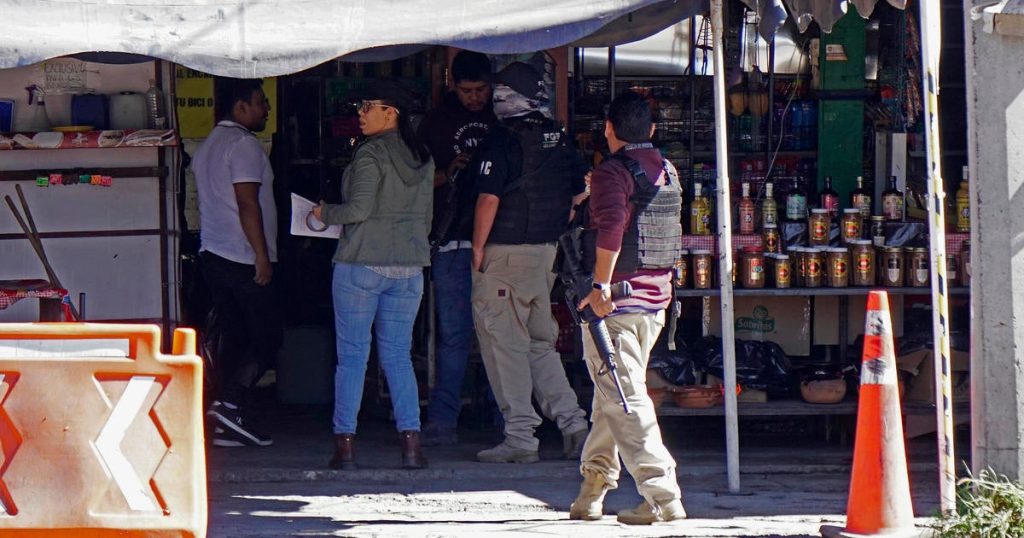Tragedy Strikes in Guanajuato: Eight Killed in Latest Wave of Violence
Mexico’s most violent state, Guanajuato, witnessed another devastating act of bloodshed on Saturday night when gunmen shot and killed eight people, including five women and three men, in the bustling municipality of Cortazar. The victims, whose identities remain undisclosed, were gunned down in the street, leaving authorities scrambling to identify the perpetrators and bring them to justice. As of now, the gunmen remain at large, and no arrests have been made in connection with the incident. This brutal attack underscores the escalating violence plaguing Guanajuato, a state renowned for its industrial prosperity and picturesque tourist attractions but also notorious for its staggering homicide rates.
Guanajuato’s dual identity as a thriving economic hub and a hotbed of cartel-related violence is a stark reminder of the complexities of modern Mexico. Despite its rich history, cultural landmarks, and contributions to the nation’s economy, the state has become a battleground for warring drug cartels. The municipality of Cortazar, where the latest massacre occurred, is no stranger to such carnage. In 2023, gunmen stormed a water park in the same area, leaving seven people dead, including a child. The recurrence of such violent incidents highlights the enduring crisis of insecurity in the region.
Cartel Wars and Rising Tensions in Guanajuato
The violence in Guanajuato is deeply rooted in a brutal turf war between two powerful drug cartels: the Santa Rosa de Lima cartel and the Jalisco New Generation cartel (CJNG). These criminal organizations have been vying for control of the state’s lucrative drug trafficking routes, leading to a spiral of bloodshed and terror. The conflict has turned Guanajuato into a war zone, with innocent civilians often caught in the crossfire. Last week, the Trump administration exacerbated tensions by officially designating eight Mexican cartels, including the CJNG, as terrorist organizations—a move that could have far-reaching implications for U.S.-Mexico relations and the region’s stability.
The U.S. State Department has issued a travel advisory for Guanajuato, urging American citizens to exercise extreme caution or reconsider visiting the state altogether. The advisory specifically highlights the high number of murders in the southern region linked to cartel-related violence. This warning reflects the gravity of the situation and the inability of local authorities to stem the tide of violence. As the cartels continue to flex their muscles, the rule of law in Guanajuato remains under constant threat.
Recent Violence in Guanajuato: A Grim Pattern
The latest massacre in Cortazar is part of a chilling pattern of violence that has gripped Guanajuato in recent months. In late October, security forces clashed with gunmen in the state, resulting in the deaths of 10 suspected criminals and leaving three police officers injured. Earlier in December, eight people were killed and two others wounded when gunmen opened fire on a roadside stand, targeting customers and bystanders indiscriminately. These incidents are not isolated; they are part of a broader wave of violence that has claimed hundreds of lives in Guanajuato this year alone.
In one particularly horrifying incident in June, a baby and a toddler were among six members of the same family brutally murdered in the state. In April, a mayoral candidate was assassinated in broad daylight as she began her campaign, a brazen act of intimidation that sent shockwaves through the political landscape. The sheer brutality of these crimes has left residents of Guanajuato living in a state of constant fear, unsure of when or where the next attack will occur.
The Toll on Innocent Lives and the Broader Context
The victims of Guanajuato’s violence are not just statistics; they are mothers, fathers, children, and community members whose lives have been senselessly cut short. The psychological and emotional toll on the surviving families and the broader community cannot be overstated. Funerals, mourning, and pleas for justice have become all too familiar in a state where peace seems elusive. The cartels’ practice of leaving threatening messages on the bodies of their victims—often to intimidate rivals or enforce their twisted codes of conduct—adds another layer of terror to the already dire situation.
The violence in Guanajuato is part of a larger national crisis. Since the Mexican government launched its military crackdown on drug trafficking in 2006, more than 480,000 people have lost their lives to drug-related violence. This staggering figure serves as a grim reminder of the human cost of the war on drugs and the failure of successive governments to dismantle the cartels’ grip on power. As the bloodshed continues, the people of Guanajuato and beyond are left to wonder when—and if—peace will ever return to their troubled land.
A Glimmer of Hope Amidst the Carnage
Amid the chaos and despair, there are faint signs of progress. On Sunday, the National Guard arrested a man believed to be a high-ranking leader of the Santa Rosa de Lima cartel’s hitmen in Guanajuato. While this arrest is a small step toward accountability, it also highlights the challenges authorities face in dismantling the complex networks of organized crime. The cartels’ ability to infiltrate and corrupt state institutions has long undermined efforts to restore order in Guanajuato and other affected regions.
For now, the people of Guanajuato can only hope that the arrest marks the beginning of a broader crackdown on the cartels responsible for so much suffering. Until then, the state will remain a symbol of both resilience and tragedy—a place where the echoes of violence mingle with the faint whispers of a future where peace might one day be possible.















